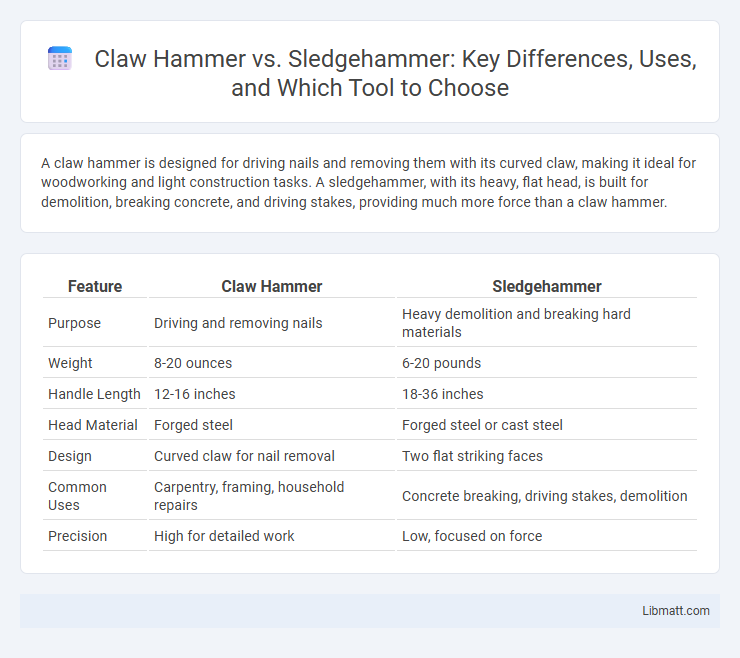A claw hammer is designed for driving nails and removing them with its curved claw, making it ideal for woodworking and light construction tasks. A sledgehammer, with its heavy, flat head, is built for demolition, breaking concrete, and driving stakes, providing much more force than a claw hammer.
Table of Comparison
| Feature | Claw Hammer | Sledgehammer |
|---|---|---|
| Purpose | Driving and removing nails | Heavy demolition and breaking hard materials |
| Weight | 8-20 ounces | 6-20 pounds |
| Handle Length | 12-16 inches | 18-36 inches |
| Head Material | Forged steel | Forged steel or cast steel |
| Design | Curved claw for nail removal | Two flat striking faces |
| Common Uses | Carpentry, framing, household repairs | Concrete breaking, driving stakes, demolition |
| Precision | High for detailed work | Low, focused on force |
Introduction to Claw Hammer vs Sledgehammer
Claw hammers and sledgehammers are essential tools in construction and demolition, each designed for specific tasks. A claw hammer features a curved, forked claw for nail removal and a weighted head ideal for driving nails into wood. Sledgehammers have large, heavy heads used for breaking concrete, masonry, and other tough materials, requiring significant force for heavier demolition work.
Key Design Differences
A claw hammer features a curved, forked claw opposite the flat striking face, designed for pulling nails and lighter carpentry tasks, while a sledgehammer has a large, heavy, double-faced head intended for demolition and heavy-duty striking. The claw hammer's handle is shorter and often made of wood or fiberglass to allow precision and control, whereas the sledgehammer's long steel or fiberglass handle provides greater leverage and force. These design differences cater to distinct applications, with the claw hammer optimized for detail work and the sledgehammer built for power and impact.
Primary Uses and Applications
Claw hammers are primarily used for driving and removing nails in woodworking, framing, and light demolition tasks due to their curved, forked claw design. Sledgehammers are designed for heavy-duty applications such as breaking concrete, driving stakes, and demolition work, offering greater impact force with their large, flat metal head. Both tools serve distinct purposes, with claw hammers favored in precision tasks and sledgehammers suited for power-intensive jobs.
Material and Build Quality
Claw hammers typically feature a high-carbon steel head paired with a hickory or fiberglass handle, optimizing durability and shock absorption for precision tasks like framing and demolition. Sledgehammers are constructed with a solid forged steel head and a reinforced ergonomic handle, often made of fiberglass or steel, designed to withstand heavy impact and deliver powerful blows. The build quality of sledgehammers emphasizes weight and balance for maximum force, whereas claw hammers balance strength with control for versatility in general carpentry.
Weight and Ergonomics
Claw hammers typically weigh between 16 to 20 ounces, offering a lightweight design that enhances precision and reduces user fatigue, ideal for driving and removing nails. Sledgehammers weigh significantly more, often ranging from 6 to 20 pounds, providing the necessary heavy impact for demolition and driving large stakes but demanding greater user strength and stamina. Ergonomically, claw hammers feature curved handles and balanced heads to improve grip and control, while sledgehammers have long, straight handles designed to maximize swinging power despite the increased strain on the wrists and arms.
Efficiency and Performance
A claw hammer offers precision and control, making it efficient for tasks like driving nails and removing them with minimal surface damage. In contrast, a sledgehammer delivers powerful impact force, optimized for heavy-duty demolition or breaking hard materials quickly. Your choice between the two should align with the scale and intensity of the project to maximize performance and efficiency.
Safety Considerations
Claw hammers offer more control and precision for tasks like driving nails, reducing the risk of accidental injury compared to the heavier and more forceful sledgehammer. When using a sledgehammer, protective gear such as safety goggles, gloves, and sturdy footwear is essential to prevent injury from flying debris and heavy impacts. Ensuring your work area is clear and maintaining a firm grip on the handle will significantly enhance safety during operation.
Maintenance and Durability
Claw hammers require regular inspection of the handle and head to ensure the head remains securely attached and the wood or fiberglass handle is free of cracks, enhancing durability. Sledgehammers, built with heavy-duty steel heads and reinforced handles, demand less frequent maintenance but should be checked for handle integrity to prevent breakage during intense use. Proper storage and cleaning extend the lifespan of both tools, ensuring Your investment lasts through numerous repair and demolition tasks.
Price Comparison
Claw hammers typically range from $10 to $40, offering an affordable option for general household tasks, while sledgehammers command a higher price, generally between $30 and $100, reflecting their specialized heavy-duty use. The higher cost of sledgehammers is due to their larger size, heavier weight, and robust materials designed to handle demolition and driving stakes. Budget-conscious buyers should consider a claw hammer for light carpentry, whereas professionals requiring forceful impact might justify the investment in a sledgehammer.
Choosing the Right Hammer for Your Needs
Choosing the right hammer depends on the task: a claw hammer is ideal for driving nails and minor demolition with its dual-purpose claw for nail removal, while a sledgehammer excels in heavy-duty jobs like breaking concrete or driving stakes with its large, flat head. Your specific project requirements and the material hardness are key factors to consider when selecting between these tools. Proper hammer choice increases efficiency, safety, and reduces fatigue during use.
Claw hammer vs sledgehammer Infographic

 libmatt.com
libmatt.com